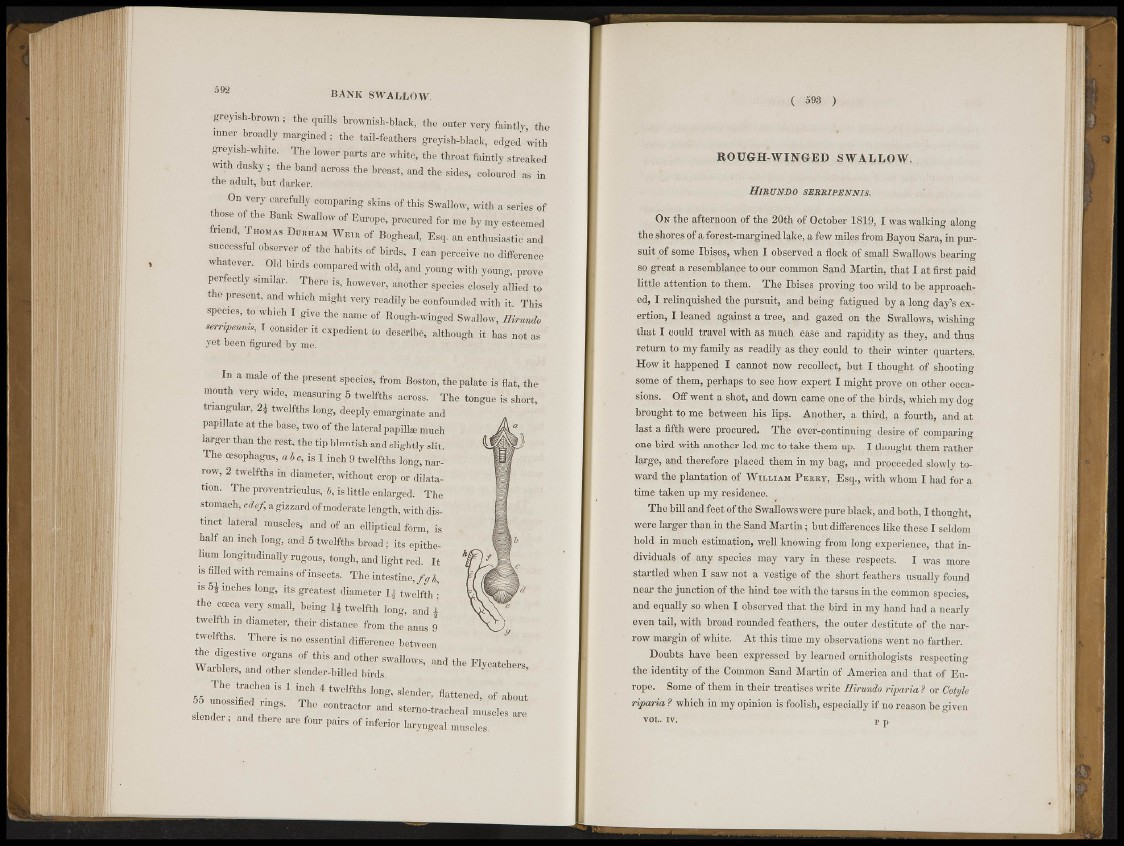
592 bank swallow.
greyish-brown ;• the quill* l.nmniA-blaok, m ^ wr> .
M a t ]
inner brpa^ margined; the tail-feathers greyistblack, etatt with
The lower parts arc M M the throAt faintly streaked
• • I 46 and t h e ^ ^ t a « , as in
Hie adult, but darter.
On very carefully comparing • of this Swallow, with a ser^of
W ofthe Bank Swallo^f «Europe', procured for m e by my e s t e ^ d
foe*, THOMAS DMHAM WE,» of Boghead^ ESQ an e n S i g l V d
successful observer of the habits « birds, I Jai perceive no difference
Whirt<,V,in: 0W • «-»mparod will! old, an.l.yolmg wi.hyiiung, „rove
perfectly similar. There is, however, another spe c i4>Vy' a l l i e d to
the present, and which might very readily be ¿onfounded'with k This
species,. to which I give the name of Bough-winged Swallow, ffM
• • 1 consiaer i t f c edi ent to describe, although it has not as '
yet been figur!ed<'by me
In a male of the present .spoci,^ fr(,ni th ( l p a l a t ( . ¡s ( |at i )h(v
mouth very wide, measurmg 5 twelfths arcros/ The tongue is short,
triangular. 2j twelfths li.ng, fle^ly emarginate and
papillate at the b®e, two' of the lateral papilhe much
larger than the rest, the tip bluntiSh and slightly slit.
The .esophagus, a he. is 1 inch 9 twelfths long, narrow,
2 twelfths in diameter, without crop or dilatat
i o n - The I>>-ov<„itricmlu.s; 4, is lit»,. , . „ 1 ^ , 1 . ' "
stOMach, < :d«f, a gizzard of moderate length, with di.s- ''
tincl lateral muscles," and of ¡11, elliptical form, is
half an inch long, and 5 twelfths broad f§fepithe- '
lium longitudin'ally rugous, tough, and light red. It
is fined with remains of mXits, The intestine, fg k, '
is 5 | indhes long, its greatest diameter 1J twelfth;
the cceca very small, being J j twelfth long, and 1
t W , ! l f t h *** diaimeter, their distance from the anus»
twelfths. There is ^essential differen^b'^een
the digestive organs of this and other sallows, and the Flycatchers
Warblers, and other slender-billed birds. -Wa e r s , I I IB 1 im;h4 BH^M flat tened^pf about
5 • • • • st^no-tracheal muscleTTe
slender; and there are four pairs of inferior laryngeal muscles
( 593 )
ROUGH-WINGED SWALLOW,
llinuxno SERRIPENNIS.
ON the afternoon of the 20th of October 1819,1 was walking along
the shores of a, forest-margined lgie, a few miles from Bayou Sara, in pursuit
pi sorru' Ibilfts, when I observed a flock of small Swallows bearing
sp great a rpsemblancg to pur common Sand Martin, that I at first paid
little attention to them. The Ibises proving tog \yild to be approached,
I relinquished the pursuit, and being fatigued by a long day's exertion,
I leaned against a tree,^ and gazed on the Swallows, wishing
that I could travel with as much ease and rapidity as they, and thus
return to my family as readily as they could to their winter quarters.
How it happened I cannot now recollect, but I thought of shooting
s<>m.e of them, perhaps to see how expert I might prove on other occa^
sions. Oif went a shot, and down came ope of the birds, which my dog
brought to me. hstireen his lips. Apother, a thirc}, a fourth, and at
last a fifth were procured. The ever-continuing desire pf cppiparing
one bird with another led me to take them jjp, I thought them rather
large, and therefore placed them in my bag, and prpgeeded slowly toward
the plantation of WILLIAM PEKKY, Ejsq., with whom I had for a
time taken up my residence.
The bill and loot of the Swallows were pure black, and both, I thought,
were larger than in the Sand Martin; but differences like these I seldom
holc§. in much estimation, well knowing from long experience, that individual
of any species n^ay vary in these respects. I was more
startled when I ga^ not a vestige of the short feathers usually found
near the junction of the hind toe with tfte tarsus in the common species,
and equally sp when I Observed that the Mud in my hand had a nearly
even tail, with brpad rpunded feathers, the cuter destitute of the narrow
margin of white, At this time my observations went no farther.
Doubts have been expressed by learned ornithologists respecting
the identity of the Common Sand Martin of America and that of Europe.
Some of them in their treatises write Birundo rvpwia ? or Cotyle
riparia ? which in my opinion is foolish, especially if no reason be given
VOL. IV. PP